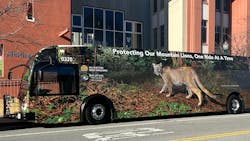The COVID-19 pandemic affected the Santa Cruz Metropolitan Transit District (Santa Cruz Metro) in a multitude of ways. During the height of the pandemic, Santa Cruz Metro lost 90 percent of its ridership, as well as approximately 20 percent of its bus operators, causing service to be disrupted.
Michael Tree was named CEO of Santa Cruz Metro in March 2022, as the agency was still navigating through the height of the pandemic and finding its “new normal.” According to Santa Cruz Metro Board Member and Former Chair Larry Pageler, Tree was hired due to his extensive expertise and knowledge of public transit, as well as his proven track record in increasing connectivity for the public.
During his year as CEO, Tree has put together a plan for the agency that is focused on three key areas:
- No more tailpipes for Santa Cruz Metro buses, as the agency looks to transition to 100 percent, zero-emission battery-electric and hydrogen buses by 2037.
- Double the agency’s ridership to seven million rides within five years.
- Develop 175 affordable housing units by 2030.
The Santa Cruz Metro Board made the decision in 2021 to convert all the agency’s compressed natural gas (CNG) buses to hydrogen and battery-electric buses. Tree notes the residents who live in the state of California are conscientious of the environment, which lends support to the agency's long-term zero-emission plans.
“The people in California are very vocal when it comes to the environment. They’re sophisticated and discerning customers, and the public was making it clear in this day and age, there were better options for the environment than hybrid diesel and CNG,” Tree said. “We’ve had riders tell us they’re happier now more than ever riding Santa Cruz Metro because the buses are zero -emissions. Riders have told us the zero-emission buses fit their values better. They know the zero-emission buses are helping maintain the environment and they are quieter than CNG buses.”
Santa Cruz Metro’s riders are not the only stakeholders to enjoy the transition to hydrogen and battery-electric buses, so have the drivers.
“I think the drivers appreciate the fact that when they touch the accelerator, the bus is moving,” Tree stated. I think that's been a benefit and a challenge because you can't just put your foot down heavy with an electric bus, or you're going to drain the battery really quick. However, you're going to get some instant feedback, and you know you've got your safety and comfort of your passengers in mind. I think it takes a little while to get used to an electric bus, but I've heard lots of drivers say they'd prefer to drive a battery-electric bus or a hydrogen bus than the other buses in our fleet.”
Santa Cruz Metro currently has four battery-electric buses in operation and is expecting five more battery electric buses to be delivered in June. A hydrogen station is in the final stages of planning and engineering, and the agency anticipates procurement of 19 hydrogen buses in the near future.
According to Tree, the decision to use more hydrogen buses as opposed to battery-electric buses is a mitigation step against a potential natural disaster.
“In our area, we're prone to natural disasters,” Tree said. “Whether it be fires or earthquakes, so the board's anticipating some event in the future will probably take away our electricity for quite a while. Having a hydrogen fleet will allow us to power a hydrogen station with a generator and keep the fleet available for assistance in the community during the emergency.”
Tree notes the hydrogen buses take a lot less time to fuel compared to the charge time of battery-electric buses. Hydrogen buses typically take 10 minutes to fully fuel, as opposed to the five-six hours it takes for the battery-electric vehicles to fully charge. The hydrogen buses also stay in service longer daily.
The agency has a goal to completely transition from CNG to zero-emission buses by 2037. Santa Cruz Metro Board Chair Shebreh Kalantari-Johnson explains the next 13 years will need to strike a balance in both the monetary outlay of the transition, as well as the time outlay on operators.
“The cost of transitioning each bus is about $1.3 million, so we have to piece together a lot of different sources of funding to be able to acquire those buses,” Kalantari-Johnson said. “We’re bringing on 28 buses in the next 12 months, which is quite a number of buses. We also have to keep in mind our workforce, so to transition our workforce and train our workforce with a new technology, we have to be mindful of that and do that in incremental steps.”
Ridership recovery
During the height of the pandemic, Santa Cruz Metro lost 90 percent of its ridership. Currently, the agency has approximately 3.5 million riders annually, which is nearly 75 percent of its pre-pandemic ridership level. Tree aims to have the agency double in ridership within the next five years.
The agency conducted a survey called Reimagine Metro, which allowed Santa Cruz County residents to provide feedback to the Santa Cruz Metro Board of Directors on what they would like to see offered on Santa Cruz Metro to get them to ride. Tree said it was clear from the survey the public wanted an easier to use and a faster, more reliable service.
Santa Cruz Metro ridership includes riders going to work and students going to University of California Santa Cruz and Cabrillo College. Santa Cruz Metro has implemented several measures to help increase ridership in the post-pandemic era, including the One Ride at a Time campaign, which aims to showcase the environmental benefits of transit, encourage bus ridership and protect Santa Cruz County’s natural resources, and Youth Cruz Free, a pilot program that launched March 1 that allows students to use their student ID cards as a pass on Santa Cruz Metro, eliminating fares in order to increase access and encourage ridership for youth through the end of high school.
Kalantari-Johnson said the Youth Cruz Free pilot program will be key to boosting ridership.
“I personally had an opportunity to meet with some youth groups last fall, and they said they would ride the bus, but they had two issues: Frequency and money, so this pilot program is so critical because if we shift the behaviors and thought processes of young people, then we shift the cultural norm around buses. You get young people to ride buses, then the rest of us are going to be more inclined to ride the bus.”
Tree notes approximately 10 percent of Santa Cruz Metro riders are under the age of 18, despite making up nearly 20 percent of the population of Santa Cruz County.
“We want to give youth freedom with moving around the region, and this is a great start for a population that loves Santa Cruz Metro,” Tree said.
Operator shortage
Santa Cruz Metro lost approximately 20 percent of its bus operators at the start of the pandemic, and has struggled to fill that void as ridership has begun to return, but it hasn’t been for lack of trying, according to Tree.
“We put in place a $4,000 hiring bonus, which has been very popular,” Tree noted. “We also put in place a referral incentive program, so if a Santa Cruz Metro employee refers someone who then becomes a bus driver at Santa Cruz Metro, the employee is given a $2,000 incentive.”
Tree explained how the agency has adapted its hiring process over the past couple of years.
“A few years ago, it used to be that potential applicants would wait a month or two until the next hiring cycle came up,” Tree said. “Now, if applicants apply, within a week, they receive a call back and are being interviewed and brought on board almost immediately if everything works out. Applicants are immediately able to give two weeks' notice to their current employer. If they’re unemployed and get on board Santa Cruz Metro, we will take them through a customer service academy while they’re waiting for the next entrance into their training.”
Santa Cruz Metro works with various community groups to better serve the community through services. The agency most recently in March distributed 200 free passes to riders, as well as 72 additional passes to community organizations affected by flooding at the Santa Cruz County Fairgrounds.
In 2021, Lani Faulkner founded Equity Transit, a social welfare organization that advocates for a robust and affordable public transportation system, a clean environment, affordable housing, safe walkable streets and opportunity access for work, school, and everyday life throughout Santa Cruz County. Equity Transit is one of many community organizations that is partnering with Santa Cruz Metro to support environmentally smart public transit, safe streets and walkable cities.
Faulkner said the pandemic showed leaders in the transit industry how many people use public transit daily.
“What the pandemic made aware to so many of us who work in transportation is we lost paratransit workers and people who could drive the buses, and that was critical for people who didn't have cars,” Faulkner said. “They were critical to our essential workers, critical to people that had to get to their doctor's appointments and could no longer do so if those buses were not available.”
The agency’s goal is to have a fully staffed bus operator roster, which consists of 150 operators, by the end of 2023. Kalantari-Johnson believes there are opportunities within the unemployed and Latinx communities to fill a lot of the positions.
“We're working with a Latinx population in Santa Cruz County throughout our county,” Kalantari-Johnson said. “They seem to be underemployed, specifically those who are predominantly Spanish- speaking residents and have limited English skills. I think part of it is the perception [where] people think their English is not up to par, so they won’t be able to interview. We’ve shifted our interview process to accommodate those with limited English, so they can feel comfortable working with Santa Cruz Metro.”
Affordable housing
Santa Cruz Metro does not think of itself solely as an agency; it thinks of itself as an essential service in Santa Cruz County. As part of that initiative, Santa Cruz Metro wants to be a part of solving the housing crisis issue in Santa Cruz County.
According to a recent study done by the National Low Income Housing Coalition, Santa Cruz County has the second most expensive rental market in the United States for housing wages at $60.35, trailing San Francisco, Calif., by $1. According to the study, housing wages are defined as an estimate of the hourly wage full-time workers must earn to afford a rental home at the U.S. Department of Housing and Urban Development’s fair market rent without spending more than 30 percent of their income.s
Data from the Santa Cruz County Community Dashboard shows 53.7 percent of Santa Cruz County residents spend 30 percent or more of their household income on rent. According to the dashboard, rental costs are comprised of rent and utilities. The dashboard also shows seven percent of Santa Cruz County households are considered overcrowded, which is defined as a household where there are more people than rooms of all types, excluding bathrooms.
“The reason why affordable housing is so essential in Santa Cruz is because of the fact Santa Cruz is one of the most expensive communities to live anywhere,” Faulkner said. “A bus driver who works in Santa Cruz County does not make the same kind of income as somebody who works in Silicon Valley. It is so expensive that our teachers, our nurses, our bus drivers can't easily afford to live here.”
The agency has a goal of developing 175 affordable housing units in Santa Cruz County by the end of 2030. Currently, Santa Cruz Metro has 248 affordable housing units under various stages of development with multiple project partners, and 128 net-zero units are planned as part of a redevelopment project at Santa Cruz Metro’s Pacific Center. The project is planned to begin construction in 2024 and also includes retail and office space.
Two other projects are also under development that include the redevelopment and construction of 60 affordable housing units as part of a redevelopment project at the Santa Cruz Metro transit center in Watsonville, Calif., approximately 20 miles from Santa Cruz County.
Tree noted the talk of housing comes up in every public meeting he attends about Santa Cruz County.
“We’re honored the public is viewing us as a community partner, not only for the public transit, but for the housing, and their symbiotic; they go together with transit-oriented development,” Tree said.
While the agency has three lofty goals it would like to hit in the future, Tree is excited to see what the agency accomplishes by the end of 2023.
“By the end of 2023, I would think we will meet the goal of being fully staffed and having all of the pre-COVID-19 service back on the street,” Tree said. “We'll have probably blown through the four million ridership mark on our way to seven million. I think we will have gotten close to putting shovels in the ground on 128 affordable housing units and the redevelopment of the Santa Cruz Transit Center. I think by the end of 2023, we'll be nearing $200,000 of financial support for improving the environment. I think we'll have ordered 19 hydrogen buses, and we'll have probably substantially completed a hydrogen station, so when those 19 hydrogen buses arrive, they can begin being fueled, so that's a pretty exciting 2023.”







